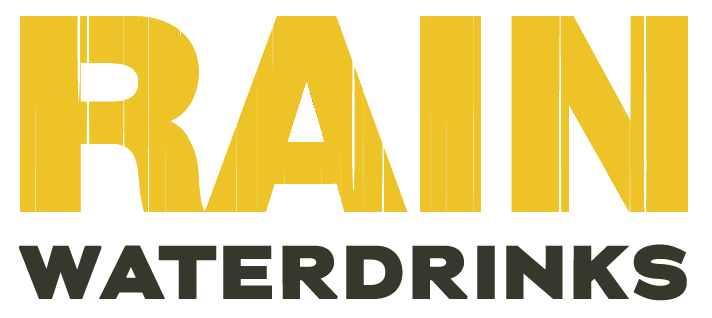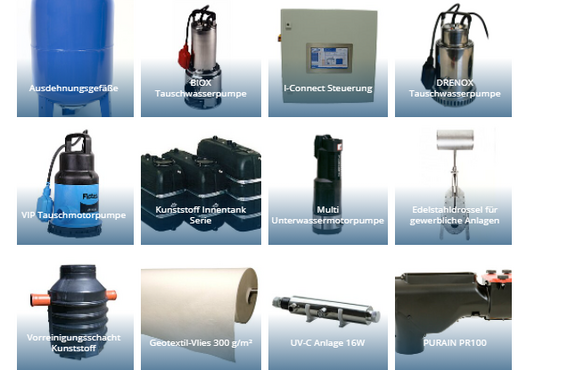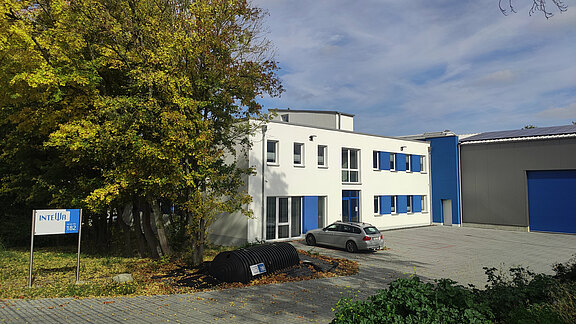Simple & inexpensive: The best home water source
Project
Single family house in Kelmis / Belgium / 2017
Application
Greywater recycling, Rainwater harvesting
Products
AQUALOOP, RAINMASTER, PURAIN
Description
Generating drinking water from rainwater simply and inexpensively with new water treatment technology
The idea of a self-sufficient water supply is not new. In most cases, these self-sufficient supply systems are found in rural, undeveloped areas and are fed with groundwater. However, not every homeowner has the possibility to use these sources. Rainwater on the other hand is available almost everywhere. However, it is hardly ever used, except for flushing toilets and watering the garden.
According to the European Drinking Water Ordinance, water of drinking water quality must be used for personal hygiene, such as showers, hand washing.
In order to meet the requirements of the EC Directive "Water for Human Use", INTEWA GmbH has implemented a special concept in a demonstration plant of a single-family home as part of the EU project "Eco Innovation". As this project does not provide sufficient rainwater for all consumers, the shower water, which is referred to as grey water after use, is collected in a further recycling stage, recycled and then reused as toilet flushing water. In parallel, heat is extracted from the grey water and used to pre-heat the shower water.
The main advantages of the so-called AQUALOOP technology
- Saving of drinking water resources
- Savings in ducts and piping systems
- Cost savings for operators and users
- more independence from the supplier
- soft, lime-free water
- no anthropogenic trace substances in the water
- simple retrofitting possible by using the existing pipe system
Retrofitting the AQUALOOP rainwater system
Rainwater is collected by the 120 m² roof surface and collected in a 10 m³ cistern.
The self-cleaning PURAIN rainwater filter (with integrated skimmer overflow, backwater flap and alternating jump principle) pre-cleans the water with the help of a 0.8 mm slotted sieve. With the AQUALOOP membrane station in the cistern, the rainwater is micro-filtered through the membrane fibres with a pore size of 0.02 µm (disinfection) and pumped into a 350 litre clear water tank in the cellar. In order to exclude any possible danger due to potential re-germination in this inner tank, the water is additionally disinfected by a UV treatment before distribution in the house.
The water thus cleaned is pumped through the speed-controlled RAINMASTER Favorit SC domestic waterworks into the existing pipe system to the tapping points in the house. The municipal water supply system, which is separate from this system, only supplies the water to the DVGW-certified RAINMASTER. The water quality of the AQUALOOP system is checked at regular intervals.
Since the existing pipe system can be used, this concept now also allows for the simple retrofitting of rainwater systems for the first time.
Overview AQUALOOP rainwater system
- Collection of rainwater from 120 m² roof surface
- PURAIN 100 rainwater filter incl. skimmer overflow and backwater flap, inlet calming device
- Storage in a 10 m³ external cistern
- AQUALOOP membrane station with ultra-, microfiltration in cistern
- 350 litre clear water tank in the cellar for sterilised water
- Withdrawal from clear water tank with RAINMASTER-Favorit 20-SC
- UV disinfection with 20 Watt for additional safety
- Pressure increase in existing piping system
- Connection to shower, washing machine, hand basin etc... Drinking water supply via RAINMASTER with city water
Water quality of rainwater
The quality of the rainwater and the cleaning performance of the plant were investigated by means of samples taken at various points of the overall system. The analysis results show that the bacterial load of the raw water from the rainwater cistern is already very low. Neither the bacterium E.Coli, an important indication of contamination with faeces, nor the pathogen Pseudomonas aeruginosa could be found in the samples.
The analysis of the treated water after microfiltration, in which no more coliform bacteria and bacterial colonies were detected, can prove the treatment potential of the membrane. According to the analysis results, additional disinfection by the UV lamp would not have been necessary, but it does provide additional safety. For all parameters examined, the limit values of the Drinking Water Ordinance for "water for human consumption" were complied with (see Table 1).
Analysis results of the AQUALOOP rainwater system
| Parameters | Limit value (according to TrinwV) | Processing by AQUALOOP |
| Escherichia coli | 0 /100ml | 0 /100ml |
| Enterococci | 0 /100ml | 0 /100ml |
| Coliform bacteria | 0 /100ml | 0 /100ml |
| Colony count 22 °C | 1000 /ml | 0 /ml |
| Colony count 36 °C | 100 /ml | 0 /ml |
| Pseudomonas aeruginosa | 0 /100ml | |
| TOC | --- | 0,85 mg/l |
| pH value on site | 9,5 | 8,58 |
| Calcium | 9,9 mg/l | |
| Magnesium | <0,5 mg/l | |
| Conductivity at 25°C | 2790 μs/cm | 64 μs/cm |
| Copper | 2 mg/l | <0,002 mg/l |
| Nickel | <0,02 mg/l | <0,005 mg/l |
| Turbidity in the laboratory | 1 NTU | 0,11 NTU |
| Clostridium perfringens | 0 /100ml | 0 /100ml |
| Nitrate | 50 mg/l | 3,4 mg/l |
| Nitrite | 0,5 mg/l | <0,02 mg/l |
| Mercury | <0,001 mg/l | <0,0002 mg/l |
| Cadmium | <0,001 mg/l | <0,003 mg/l |
| Source: Institut für Wasser- und Abwasseranalytik GmbH |
AQUALOOP greywater recycling
In the present demonstration project the rainwater alone is not sufficient to cover the entire water requirements of the family of four. Through the additional recycling of the grey water from the shower and hand basin, a further approx. 30 m³/year of water can be saved, thus covering the entire water requirement (100m³/year). This "rain" water, which is only relatively slightly contaminated by personal hygiene, is cleaned in the AQUALOOP grey water recycling plant and then used to flush the toilet. In contrast to the rainwater cistern, the greywater system manages with two very small reservoirs (2 x 350 litres), which cover the approximate daily requirement. For cleaning, the AQUALOOP pre-filter first separates coarse contaminants such as hair. Then the water in the aerated fluidised bed is biologically purified by micro-organisms that colonise the fillers in the treatment tank. Microfiltration in turn takes place by drawing the water through the pores of the hollow fibre membrane in the AQUALOOP membrane station. The biologically purified and sterilised water meets at least the EU bathing water quality. The RAINMASTER Eco domestic waterworks pumps the treated water from the clear water tank of the grey water system to the toilet.
Analysis results of the AQUALOOP grey water system
| Water parameters | NSF specification | Grey water |
| E. Coli | 14 /100ml | <1 /100ml |
| Turbidity | 5 NTU | 0,5 NTU |
| pH | 6-9 | 7,8 |
| BSB5 | 10 mg/l | 5 mg/l * |
| *after 8 weeks running-in phase | ||
| Source: PIA Prüfinstitut für Abwassertechnik GmbH |
Overview AQUALOOP grey water system
- aerated fluidised bed bioreactor in 350 litre tank
- AQUALOOP pre-filter incl. skimmer overflow, siphon overflow and backflow flap AQUALOOP membrane station with ultra/microfiltration
- Intermediate storage in 350 litre clear water tank
- Withdrawal from clear water storage tank with RAINMASTER-Eco (100 Watt output), pressure increase in separate service water pipe to the toilet
- Replenishment via treated rainwater
Risks
The immediate danger of the transmission of pathogens through rainwater is eliminated by AQUALOOP disinfection. Depending on the location of the rainwater system, however, it is necessary to check which parameters need to be investigated in order to maintain drinking water quality even with the dissolved chemical substances. In the case of copper or zinc roofs, for example, there could be an increased input of these metals. In areas where the air is polluted by unpurified flue gases from combustion, so-called "acid rain" could occur. Due to the low pH-value, the risk of metals being released by corrosion increases. The pH-value should then be neutralized with simple measures. In regions with very poor air quality, heavy metals can be washed out of the atmosphere. In the vicinity of high-emission industries or very high traffic volumes, corresponding concentrations in rainwater should therefore be checked. In most European countries, however, air pollution has not played a role for years due to improved environmental protection measures and the quality of rainwater is very good.
Costs and saving potentials of the demonstration project
If one looks at the costs and the savings potential of this technology, it is clear that it is not possible to make generally valid statements due to the different water costs, charging models and consumption. Often, however, interesting payback periods can already be achieved with this new system technology, which are significantly below the service life of the buildings. The own water supply with rainwater can therefore make sense in many areas:
| Place | Kelmis, Belgien |
| Catchment area | 120 m² |
| Rainwater yield | ca. 90 m³ / year |
| Water consumption 4 persons* | ca. 105 m³ / year |
| RW consumption | ca. 70 m³ / year |
| GW consumption | ca. 30 m³ / year |
| Savings potential | ca. 100 m³ / year |
| Average water prices in Germany** | 5,00 €/ m³ |
| Electricity costs system / m³ at 0,23€/kWh | 0,43 €/m³ |
| Savings potential DE after deduction of electricity costs | 4,57 €/m³ |
| Model 1***: Rain- and grey water | Total costs approx.15.684,00 € Static amortisation 16,73 years |
| Model 2***: Only rainwater | Total costs approx. 9621,15 € Static amortisation 12,03 years |
| Model 3***: Only rainwater all work done by the customer | Total costs approx. 7241,15 € Static amortisation 9,05 years |
* for comparison: Ø water consumption 4 persons Germany 180 m³,
Ø Water consumption 4 persons USA 430 m³
** Drinking and waste water costs, in case of fee splitting the waste water fee cannot be calculated
*** Ø water consumption of 175 m³/year Table 3: Costs and potential savings
Summary
This EU-funded demonstration project impressively demonstrated that the new AQUALOOP technology makes it possible to substitute almost the entire water consumption of a single-family house from rainwater.
It is remarkable that this can already be economical today when retrofitted into an existing building. This technology is therefore of interest both for new buildings and for existing houses.
If there is not enough rainwater available, the gap can be closed by recycling the grey water produced. In addition, a heat exchanger enables heat to be recovered from the warm grey water.
AQUALOOP technology can represent a new business area for the future for specialist companies in the field of water treatment, rainwater utilisation and storage tank manufacturers.
The saving of valuable drinking water reserves is also an important contribution to the environment.




![[Translate to English:] [Translate to English:]](/fileadmin/_processed_/4/0/csm_AL_Anlage_OR_einsetzen_Zisterne06_06023be0b1.jpg)
![[Translate to English:] [Translate to English:]](/fileadmin/_processed_/3/d/csm_AL_GWN_Ringelstein_d0ff4527b1.jpg)
![[Translate to English:] [Translate to English:]](/fileadmin/_processed_/f/1/csm_AL_RWN_Ringelstein_6df673f331.jpg)
![[Translate to English:] [Translate to English:]](/fileadmin/_processed_/2/f/csm_Gesamt%C3%BCbersicht_AL_Regen-undGrauwasseranlage_6c313d9b31.png)